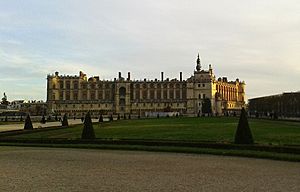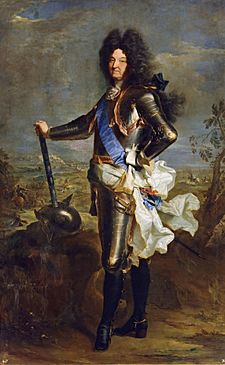Simon Fraser, 11th Lord Lovat facts for kids
Quick facts for kids
Duke of Fraser (Simon Fraser 11th Lord Lovat)
|
|
|---|---|
| Duke of Fraser 11th Lord Lovat | |
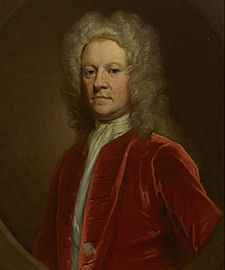
Duke of Fraser, (Simon Fraser, 11th Lord Lovat)
|
|
| Tenure | 1699–1746 |
| Predecessor | Thomas Fraser, 10th Lord Lovat |
| Successor | Thomas Fraser, 12th Lord Lovat |
| Other titles |
|
| Born | 5 January 1667 |
| Died | 9 April 1747 (aged 80) Tower Hill, London, England |
| Nationality | French-Scottish |
| Spouse(s) |
|
| Issue |
|
| Parents |
|
Simon Fraser, 11th Lord Lovat (born around 1667 – died 9 April 1747 in London), was a powerful Scottish clan chief. He was known as "the Fox" because he often changed his loyalties. Simon Fraser was the leader of Clan Fraser of Lovat.
He first supported the House of Hanover (the ruling family of Great Britain) in 1715. But in 1745, he switched sides. He then supported the Stuart family's claim to the British throne. The Stuarts were the previous royal family. Lovat was among the Highland chiefs defeated at the Battle of Culloden. He was found guilty of going against the Crown. He was then sentenced to death and executed.
Contents
Early Life and Education
Simon Fraser was the second son of Thomas Fraser of Beaufort. His mother was Lady Sybilla MacLeod. The Beaufort Frasers were the traditional chiefs of the Highland Clan Fraser. Simon was taught at home near Beauly.
He was a very good student. He learned to speak English, French, and Gaelic fluently. He also had a strong understanding of Latin.
His older brother, Alexander, died fighting for the Jacobites. The Jacobites were people who supported the Stuart family's claim to the throne. Simon then became his father's heir. He went to King's College, Aberdeen for his studies. He was a "diligent student" and earned a Master of Arts degree in 1695.
At this time, the clan needed strong leadership. Simon wanted to make sure his father would become the next Lord Lovat. He also wanted to protect his clan from the growing power of other clans. He decided to join the army to achieve his goals. He went to Edinburgh and gathered 300 men from his clan. They joined a regiment serving King William III and Queen Mary II.
In 1696, Hugh Fraser, the 9th Lord Lovat, decided that the Beaufort Frasers would inherit the Lovat title. Hugh died that same year. Simon's father, Thomas of Beaufort, then became the 10th Lord Lovat. However, another powerful Scottish leader, Lord John Murray, challenged this.
Seeking a Royal Pardon
Simon faced many challenges in trying to control the Fraser lands. The legal system was not on his side. However, he found a strong supporter in Archibald Campbell, the Earl of Argyll. Argyll was the chief of the powerful Clan Campbell.
Argyll advised Simon to go to London. He told him to ask King William for a pardon. The King was worried about keeping peace in Scotland. In 1700, Simon was granted a pardon. This meant he was finally free to take the title of Lord Lovat. He could also live in the family's main home, Castle Dounie.
However, Simon's good luck did not last long. He still faced legal problems from the Murrays. In 1701, he was declared an outlaw again. This meant he was outside the protection of the law. In 1702, King William III died, and Queen Anne took the throne. She favored Lord John Murray over Argyll.
Later in 1702, Hugh, the 9th Lord Lovat's daughter, Amelia, married Alexander Mackenzie. Alexander took the name 'Alexander Mackenzie of Fraserdale'. This marriage meant that the Mackenzie family could take over the Fraser lands. Simon was in London at the time. On Argyll's advice, Lovat left Britain. He went to France to the court of the exiled Stuart family. He hoped they might help him get his inheritance back.
At the Court of Exiles
The Stuart family had been exiled for 15 years. They still hoped to regain the thrones of England and Scotland. James II had died, but his 14-year-old son, James, was ready to lead. The court in exile was divided. One group wanted a peaceful return to the throne. The other group, which Simon joined, wanted an armed uprising in Scotland. They hoped France would help them.
Simon decided to convert to Catholicism. The Stuart court was very Catholic. After becoming Catholic, Simon met with the King of France, Louis XIV, at Versailles. Simon spoke good French. He presented a plan for the Jacobite clans in the Highlands to rise up. French troops, weapons, and money would help them.
He suggested that 5,000 French troops would land in eastern Scotland. Another 500 men would land in the west. They would all march towards Edinburgh. Along the way, more men from the clans would join them. Simon's idea of involving the Highlanders was new and important. Some writers believe this plan became the basis for the major Jacobite uprisings in 1715 and 1745.
The Jacobite leaders agreed to the plan. However, they were cautious. They sent Simon back to Scotland. He was to get written proof that the Highland clans would indeed rise up. So, after a year in France, Simon returned to Scotland in 1703. He began preparing for an invasion and uprising. He hoped this would help him reclaim his title and lands.
Changing Sides
In 1703, Simon Fraser returned to Britain. He had some blank documents signed by James Francis Edward. He first visited London, then Scotland. He learned that while people were unhappy with Queen Anne's government, the Highland chiefs were not eager for another uprising.
In September, he met James Douglas, the Duke of Queensberry. Queensberry was Queen Anne's representative in the Scottish parliament. Simon shared details of the French invasion plans with him. He also showed him a letter from James's mother. Simon suggested the letter was meant for Lord John Murray.
Fraser's main goal was to get back his Lovat title and lands. His brother, John, tried to keep their clansmen loyal. But some were starting to accept Alexander Mackenzie in Simon's place. Later, it seemed that Simon's actions were a way to get his political enemies, like Atholl and Queensberry, in trouble with the government. If the uprising failed, this would help him get back into the government's good graces.
Queensberry, who supported the union of Scotland and England, was happy to get information against Atholl. He gave Fraser a passport under a false name. This allowed Fraser to leave the country. Rumors about Fraser's return were spreading. People were calling for his capture. So, Fraser had to return to France to explain himself.
Imprisonment in France
When he returned to France in late 1703, Lovat wrote a report for James's mother. It said that Jacobite support in Scotland looked good for her son's return. But soon, news of his changing loyalties reached Paris. King Louis XIV first sent Lovat into exile in the middle of France, at Bourges.
Lovat misunderstood how much he was out of favor. He used money from the French King to pay for big parties. These parties celebrated French military wins. Louis XIV then sent him to prison at Angoulême. He stayed there for three years. He could not influence events from prison. In 1707, he was moved to the town of Saumur. He was not in prison there. He could write letters and have visitors. But he was not allowed to visit Paris or Scotland.
The 1715 Rebellion
Even in 1714, many Fraser gentlemen still did not accept Alexander Mackenzie as their chief. Alexander was married to the heiress and lived at Castle Dounie. A group of Fraser gentlemen sent James Fraser of Castle Leathers to Saumur. Their goal was to bring Simon back home. After some thought, Simon agreed. They returned to Britain. Simon then waited in London to find out his legal status.
At this point, big political events happened. Queen Anne died without children. George of Hanover became the new King. In response, a Jacobite rebellion started in Scotland in September 1715. It was led by the Earl of Mar. Simon saw this as a chance to clear his name. He got permission to return to Scotland. He helped gather the Fraser clansmen to support the government.
After a difficult journey north, Fraser finally met his loyal clansmen. They were outside Inverness, which Jacobite troops had taken over. The Clan Mackenzie had already joined the Stuart King in France. Several hundred Fraser men had also joined them. But when they heard Simon was back, many left the Jacobite army. Simon's energy and smart tactics helped the government's efforts in the north. He helped make sure no more Jacobite troops arrived. This sped up the surrender of Inverness on 12 November 1715.
Getting His Title and Lands Back
For his help, Simon Fraser received a full pardon from the King in March 1716. This meant he could now live at Castle Dounie as the 11th Lord Lovat. He no longer feared being arrested or executed. Later that year, the King made another agreement. Simon could also claim the money from the estates. This was for the lifetime of the previous tenant, Alexander Mackenzie. Alexander was in jail for supporting the Jacobites.
As a sign of his return to good standing, Lovat was also made Governor of Inverness Castle. He was given command of his own Company of Foot (a military unit).
The rest of Simon's life involved sorting out legal and money problems. He had inherited these issues with his title. He also fought lawsuits from different people in court. One big legal fight was with Alexander Mackenzie. Alexander had been pardoned for his part in the 1715 rebellion. They argued over the income from the estates. This went on in court until the 1730s. Only then, after paying a large sum of money, did Simon finally have full control of his title and lands.
Lovat as Clan Chief
Lovat believed a clan chief should be like a medieval lord. He did not like it when leading clansmen disagreed with him. He often argued fiercely with men like Alexander Fraser of Phopachy. But he showed a fatherly interest in the lives of his less powerful clansmen.
He often carried a bag of small coins. He would give these to any beggars he met. He would stop people on the road and ask about their children. He would offer good advice. He also promised to help them if they had problems.
He made sure his clansmen were "always well-clothed and well-armed, after the Highland fashion." He did not let them wear "low-country clothes." In return, he kept a grand table at his castle. There was "great abundance of all kinds of meat – and drink." This was really a way of sharing the rent he collected from his clansmen.
Family Life
Simon Lovat married Margaret Grant in 1717. This marriage was very successful for Lovat. They had three girls: Georgina, Janet, and Sibyl. They also had two boys: Simon and Alexander. Simon, born in 1726, became the Master of Lovat.
Margaret died in 1729. Four years later, Lovat married 23-year-old Primrose Campbell of Mamore. They had one child, Archibald. But this marriage was not happy, and they separated in 1738. Lady Primrose lived in Edinburgh after their separation.
Lady Lovat was forced to live quietly at Castle Downey after Simon's execution. Even though she officially lost her title, people still called her "Lady Lovat." Archibald Fraser became a merchant in London.
Changing Loyalties Again
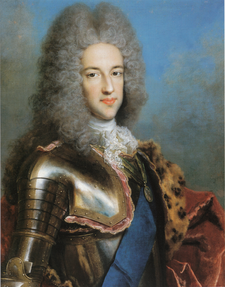

Jacobite ideas focused on obeying social leaders and old traditions. In Scotland, this was strong among clan leaders. Some people thought Lovat was "always a Jacobite" at heart. They believed his loyalty to the London government was just a way to keep or get back his title and lands. It seems that Lovat's support for both the Stuarts and their rivals depended on what was best for him personally.
After a failed Jacobite uprising in 1719, the government realized they needed the help of clan chiefs to control the Highlands. Many Jacobite exiles were pardoned and returned home. This worried Lovat, as it threatened his influence with the government.
In the early 1730s, Lovat had disagreements with his Whig allies. By 1737, he started talking to the Stuart exiles again. In 1739, James offered him a dukedom. This was enough to get Lovat's support for forming the Jacobite Association with other Scottish leaders. The government found out about this. In 1740, they removed him from command of his Independent Company. Lovat saw this as a great insult.
The 1745 Rising
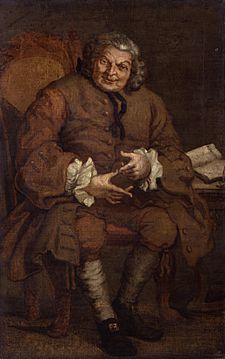
On 23 July 1745, Charles Edward Stuart (also known as Bonnie Prince Charlie) landed in Scotland. Many Scots had told him not to come unless he brought French troops, weapons, and money. Many advised him to go back to France. Lovat sent messages of support to both sides. He also kept in touch with Duncan Forbes, who hoped Lovat would stay neutral. At this time, men were training on Lovat's land. Only he knew why, and the law waited for him to choose a side.
Lovat's choices were complicated. Some of the main Jacobite leaders were his old enemies. After a victory at Prestonpans in September, Lovat made his choice. He ordered his son, Simon, Master of Lovat, to join the Jacobites. Simon, the son, was a political Whig. He thought the uprising was foolish. But a person at the time noted that his father was "a very strict man" with great power over his children.
Following Lovat's orders, the Frasers tried to kidnap Duncan Forbes in October. They also attacked Fort Augustus in early December. Finally, the government lost patience. They arrested Lovat at Castle Dounie and took him to Inverness. On 2 January, he easily escaped. Fraser clansmen took him to Gorthleck House, overlooking Loch Ness.
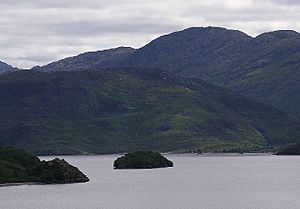
Only some of the Fraser regiment were at the Battle of Culloden in April 1746. Like many others, the main part of the regiment arrived at daybreak. They were tired from a failed night march and missed the battle. The Frasers were one of the few Jacobite groups to retreat in an orderly way. They went towards Inverness, where they met the rest of their unit.
Bonnie Prince Charlie was taken from the battlefield to Gorthleck House. He met Lovat there. Lovat advised him to gather his forces in the hills. The next morning, they went their separate ways. Lovat was rowed across Loch Ness. But his escape was difficult because of his health problems. He had to be carried on a stretcher.
After Culloden, the Duke of Cumberland realized the British Army did not have good maps of the Scottish Highlands. This made it hard to find Jacobite supporters like Simon Fraser. This led to the creation of the Ordnance Survey, which makes maps. During the search for Jacobites, John Ferguson found out Lovat was hiding on an island in Loch Morar. Lovat was arrested on 7 June.
He was taken to London for trial. One of his stops was at St Albans. There, artist William Hogarth sketched him. The sketch shows him counting points on his fingers.
Trial and Execution
Lovat was held in the Tower of London. His trial for high treason began in March 1747. The trial took place at Westminster Hall and lasted seven days. For the first five days, evidence was presented against him. On the sixth day, he spoke in his own defense. But the outcome was already clear. He was found guilty at the end of the day. On the final day, he was sentenced to a traitor's death by execution.
He remained calm in the days before his execution. He even showed a sense of humor. On the day of his execution, 9 April 1747, many people came to Tower Hill to watch. A crowded wooden stand collapsed, killing nine spectators. Lovat found this amusing. His laughter at this event, even as he was about to be executed, is said to be the origin of the phrase "to laugh one's head off." Among his last words was a line from a Roman poet: Dulce et decorum est pro patria mori (meaning: "It is sweet and right to die for one's country"). In his own view, he died as a Scottish patriot.
Burial Place
The government first agreed that Lovat could be buried at his family's mausoleum. This was at Wardlaw near Inverness. But in the end, they decided to follow the usual practice for those executed at Tower Hill. Lovat and two other Jacobite lords were buried in St Peter ad Vincula. This is a chapel connected to the Tower of London. When the chapel was renovated in the 1800s, a coffin with the nameplate 'Lord Lovat' was found. His name is now on a plaque on the chapel wall.
For over 250 years, his family believed his body was secretly moved. They thought it was buried in the mausoleum. A lead-covered coffin in the crypt had a bronze nameplate for Sir Simon Fraser. It had a Latin message. This message was thought to be written by Lovat himself. It talks about "the tyranny of the Athol and the treacherous plotting of the Mackenzies of Tarbat."
However, in 2018, scientists from the University of Dundee studied the bones in the coffin. They found that the bones belonged to a young woman, not Simon Fraser. One idea is that the coffin was prepared for Lovat. But when the government changed its mind, it was sent to Wardlaw anyway. Investigations are still ongoing.
At the bottom of the plaque is an engraving of the Lovat Coat of Arms. Instead of a baron's crown, it has a duke's crown. In 1740, James Francis Edward Stuart (who claimed to be James III of England and VIII of Scotland) made Lovat a Duke. He gave him titles like Duke of Fraser and Marquess of Beaufort.
Next to his coffin are those of his two sons, General Simon Fraser (1726–1782) and Archibald Campbell Fraser (1736–1815). Also buried there are Archibald's wife Jane and two of their children. Archibald's children all died before him. He asked that the family estate go to Thomas Alexander Fraser of Strichen. The current Lovat Fraser family comes from him.
In Fiction
Simon Fraser, 11th Lord Lovat, appears as a character in several books. These include A Lost Lady of Old Years (1899) by John Buchan. He is also in The New Road (1914) by Neil Munro. Another book is The Books of the Incarceration of the Lady Grange (2016) by Andrew Drummond.
He is also in Diana Gabaldon's 1992 novel Dragonfly in Amber. This is the second book in her Outlander series. In the story, Lovat is the grandfather of Jamie Fraser. Clive Russell plays Lovat in Season 2 of the TV show Outlander.
See also



